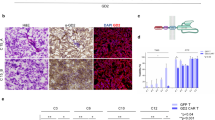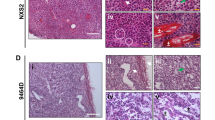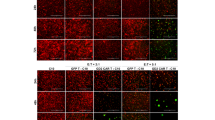Abstract
Neuroblastoma (NB) is the most common extracranial solid neoplasm of infancy and is associated with very poor prognosis in patients with advanced disease1,2. Current therapeutic regimens of advanced NB which combine surgical resection with radiation therapy and/or chemotherapy brought some improvements, but in a significant number of patients, a cure remains elusive3. Normal human serum of healthy adults contains natural IgM antibodies that are cytotoxic for human NB cells. In this study, we evaluated the anti–NB activity of these natural IgM antibodies in nude rats bearing solid human NB tumors. A single intravenous (i.v.) injection of purified cytotoxic IgM led to uptake of IgM into the tumors with massive perivascular complement activation and accumulation of neutrophil granulocytes after 24 hours. Five consecutive i.v. injections of purified cytotoxic IgM into NB–bearing animals resulted in complete growth arrest of even large and established solid tumors which lasted for several weeks after discontinuation of the injections, whereas tumors of control animals continued to grow exponentially during the observation period. These studies suggest that natural anti–NB IgM may have a potential as a novel therapeutic modality in the treatment of human NB.
This is a preview of subscription content, access via your institution
Access options
Subscribe to this journal
Receive 12 print issues and online access
$209.00 per year
only $17.42 per issue
Buy this article
- Purchase on Springer Link
- Instant access to full article PDF
Prices may be subject to local taxes which are calculated during checkout
Similar content being viewed by others
References
Siegel, S.E. & Sato, J.K. Neuroblastoma. in Oncology, (eds. Moossa, A.R., Robson, M.C. & Schimpfl, S.C.) 1211–1231 (Williams St Wilkins, Baltimore, 1986).
Pinkerton, C.R. Neuroblastoma in the 1990s. A clinical perspective. in Human Neuroblastoma: Recent Advances in Clinical and Genetic Analysis. (eds. Schwab, M., Tonini, G.P. & Bénard, J.) 3–10 (Harwood Academic Publ., Chur, Switzerland, 1993).
Philip, T. & Pinkerton, R. Neuroblastoma. in New Directions in Cancer Treatment. (ed. Magrath, J.) 605–611 (Springer, Heidelberg, Germany, 1989).
Ollert, M.W. et al. Normal human serum contains a natural IgM antibody cytotoxic for human neuroblastoma cells. Proc. Natl. Acad. Sci. U.S.A. (in the press).
Dixon, F.J., Vasquez, J.J., Weigle, W.O. & Cochrane, C.G. Pathogenesis of serum sickness. Arch. Pathol. 65, 18–25 (1958).
Handgretinger, R. et al. The possible role of granulocytes in the therapy of neuroblastoma. in Human Neuroblastoma: Recent Advances in Clinical and Genetic Analysis. (eds. Schwab, M., Tonini, G.P. & Bénard, J.) 24–33 (Harwood Academic Publishers, Chur, Switzerland, 1993).
Bruchelt, G. et al. Effect of granulocytes on human neuroblastoma cells measured by chemiluminescence and chromium-51 release assay. J. Eiolumin. Chemilumin. 3, 93–96 (1989).
Barker, E. et al. Effect of a chimeric anti-ganglioside GD2 antibody on cell-mediated lysis of human neuroblastoma cells. Cancer Res. 51, 144–149 (1991).
Barker, E. & Reisfeld, R.A. A mechanism for neutrophil-mediated lysis of human neuroblastoma cells. Cancer Res. 53, 362–367 (1993).
Kushner, B.H. & Cheung, N.-K.V. GM-CSF enhances 3F8 monoclonal antibody-dependent cellular cytotoxicity against human melanoma and neuroblastoma. Blood 73, 1936–1941 (1989).
Savill, J., Fadok, V., Henson, P. & Haslett, C. Phagocyte recognition of cells undergoing apoptosis. Immunol. Today 14, 131–136 (1993).
Ouchterlony, Ö. & Nilsson, L.-Å. Immunodiffusion and immunoelectrophoresis. in Handbook of Experimental Immunology: Immunochemistry. 19.1–19.44 (ed. Weir, D.M.) (Blackwell Scientific Publ., Oxford, UK, 1978).
Vogel, C.-W. & Müller-Eberhard, H.J. Cobra venom factor: Improved method for purification and biochemical characterization. J. Immunol. Meth. 73, 203–220 (1984).
Juhl, H. et al. A monoclonal antibody-cobra venom factor conjugate increases the tumor-specific uptake of a 99mTc-anti-CEA antibody by a two-step approach. Cancer Res. 55, 5749s–5755s (1995).
Mujoo, K. et al. Functional properties and effect on growth suppression of human neuroblastoma tumors by isotype switch variants of monoclonal antiganglioside GD2 antibody 14.18. Cancer Res. 49, 2857–2861 (1989).
Burck, H.-C. Physikalische und physikochemische Färbemethoden. in Histologische Technik. 104–141 (Georg Thieme, Stuttgart, Germany, 1988).
Laemmli, U.K. Cleavage of structural proteins during the assembly of the head of bacteriophage T4. Nature 227, 680–685 (1970).
Author information
Authors and Affiliations
Rights and permissions
About this article
Cite this article
David, K., Ollert, M., Juhl, H. et al. Growth arrest of solid human neuroblastoma xenografts in nude rats by natural IgM from healthy humans. Nat Med 2, 686–689 (1996). https://doi.org/10.1038/nm0696-686
Received:
Accepted:
Issue Date:
DOI: https://doi.org/10.1038/nm0696-686
This article is cited by
-
Prenatal Exposures and Childhood Cancer
Pediatric and Developmental Pathology (1999)



